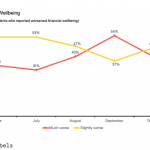Speculating on the Future of Financial Inclusion: Predictions, Solutions (and Warnings) for the Next 20 Years
In two recent blogs on the MSC website, I examined the evolution of the financial inclusion industry in the 20 years since MicroSave was established in 1998. In this blog, I will play the fool’s game of looking forward to what might happen in the next 20 years.
The future will inevitably prove me wrong on many points, but these predictions should, at a minimum, highlight some trends and technologies that are likely to play important roles in the sector’s ongoing development.
The Potential of Technology
We live in extraordinary times: In the next 20 years, those of us privileged to live in wealthy countries can expect to see drone deliveries, driverless cars and Hyperloop trains in use in our communities. Virtual reality will replace textbooks, fully furnished, 3D printed houses will come into being and the Internet of Things will be ubiquitous, while robotics will replace millions more jobs. We can also expect to see Big Data analytics integrated into everything we do — used both by those who want to sell to us and the governments that “take care” of us. As a result, the combination of smartphones, computers, CCTV cameras, sensors, wireless communication satellites and GPS will eradicate most forms of privacy.
And these are just the easily predictable innovations: Some analysts point to a future marked by technologies that are far harder to foresee. For instance, Ray Kurzweil, a Director of Engineering at Google makes remarkable predictions based on his Law of Accelerating Returns, which states that technology is progressing at an exponential rate — much faster than our traditional linear way of thinking. This acceleration will provide unimaginable advances in just a few decades, from DNA manipulation and nano-bots that can ensure immortality, to “the singularity,” in which computers merge with man, unlocking astonishing new capabilities. Ultimately, Kurzweil predicts, this massive degree of technological development will largely eradicate wars, disease and hunger by 2050.
No less an authority than Bill Gates extends some of this optimism to financial inclusion. In his 2015 Annual Letter, he wrote, “By 2030, 2 billion people who do not have a bank account today will be storing money and making payments with their phones, and by then, mobile money providers will be offering the full range of financial services, from interest-bearing savings accounts to credit to insurance.”
I won’t hazard a guess on the likelihood of the singularity – much less predict a date. But I find Gates’ predictions on financial access to be quite realistic. The question is: Will the distribution of these innovations be equitable? That’s less clear.
History teaches us that humanity is remarkably poor at sharing wealth and well-being. Will it be different in the next 20 years? Much will depend on how effectively we choose to address the six core drivers of the digital divide—and this will largely be determined by the seventh core driver: the business case to do so. Let’s examine some of the technological and social/psychological barriers to this potential progress – and how these challenges can be overcome.
Technological Barriers and Solutions
The prospects for the equitable division of tech-generated revenue in emerging countries do not look positive. The Brookings Institution report of 2016 on income inequality concluded, “The basic story that emerges from a review of the evidence on income distribution is one of steady and often major increases in inequality within countries over the past about three decades.” If the poorer countries and populations within those countries do not reap the benefits of the increasing prosperity arising from the new digital age, private sector entrepreneurs are unlikely to invest in providing products and services to them.
At present, the low-income market does not buy enough to warrant the data-driven, targeted digital marketing that sustains Facebook, Google and so many other platforms and apps. And even where the poor can access the internet, they do so with what Jonathan Donner calls the “metered mindset, in which people don’t surf and browse, but rather sip and dip.” This lack of a strong business case is a major impediment to access: As the Collaboration on International ICT Policy in East and Southern Africa notes, “Internet penetration in Africa stands at 21.8% of the population, leaving the majority of the continent’s population offline.” If these conditions persist, we risk seeing digitally enabled hotspots only in urban and peri-urban areas where it is profitable to deliver digital services — and digital deserts in rural and remote areas. As others reap the benefits of enhanced education, healthcare, agriculture, enterprise and financial services, those stranded in the digital deserts would be left to struggle with basic analog and 2G products. This would inevitably lead to increased rural to urban migration, the outcomes of which are much debated.
Addressing this digital divide will require concerted efforts from governments, development agencies and the private sector, which must work together to provide an enabling environment and digital ecosystems for the development of new products. This is where initiatives to build infrastructure, like the Gates Foundation’s Mojaloop, can play a necessary (but probably not sufficient) role. E-platforms such as Google/Alphabet, Apple, Facebook and Amazon, and Chinese companies such as Baidu, Alibaba Group, Tencent Holdings and JD Group could also play a central role. However, they would rather ride on functioning ecosystems than roll out their own.
To help create these ecosystems, Universal Service Funds (USFs) have been collected in many countries, often as a percentage of the gross revenues of telecommunication companies. These funds are specifically designed to extend mobile coverage to more remote areas. However, studies show that globally, over half of the sums collected for USFs were never utilized, and more than a third of the funds were not able to distribute any of the money collected. Governments will need to increase the collection and improve the use of these USFs – and we need to find credible alternatives for rolling out internet coverage to remote areas.
Fortunately, these alternatives exist. With the switch to digital TV, the analog TV spectrum can be repurposed to deliver mobile network coverage via lower frequency signals, which travel greater distances before weakening. Therefore, to cover remote rural areas, MNOs would need fewer towers and base stations than they currently require (though the economics of this will require careful management).
Another solution would be to incentivize the deployment of balloons, low-orbit nano-satellites and other sources of low-cost remote connectivity. However, this will need to be done with care, understanding and empathy. While Facebook’s Free Basics has already connected 100 million people in 60 countries, its limited internet access precludes the availability of some of the very apps that could unlock increases in income. In the words of Mike Santer, founder of BluPoint, “Western companies need to show more awareness that what works for them does not always translate to the developing world.” A better approach, he says, would be for big tech companies to partner with local organizations that understand the local language, culture, market needs and opportunities.
Social and Psychological Barriers and Solutions
However, providing access to this technology doesn’t guarantee that people will use it. Consider the fact that more than 1 billion people globally, in both rural and urban areas, cannot read or write, or understand the long number strings necessary to transact in the digital age. Natural language processing (NLP), a branch of artificial intelligence that helps computers understand and manipulate human language, can enhance these people’s ability and willingness to interact and transact with each other, and with service providers. However, most of them do not speak one of the top 30 global languages as their first language — none of which are indigenous to Africa. And for obvious commercial reasons, the languages spoken by a limited number of (often relatively poor) people are less likely to be the focus of NLP products. Furthermore, many of the poorest are women who face social barriers that exclude them from the digital revolution, even if NLP is rolled out in their language.
If we can get connectivity and smartphones into the hands of people in remote and rural villages, helping people who cannot read or understand number strings should be relatively easy. Indeed, MSC’s MoWo project is already starting this, using icons instead of words, with plans for a cash calculator with an interface specifically designed for this population. This will need to be tailored for each cultural context, but depending on the development of NLP, it may well be a more cost-effective approach for less-common languages.
That said, with the evolution of artificial intelligence, the next 20 years may see the development of commercially viable NLP for these languages. Alternatively, governments may commission or cost-share the development of NLP for the diverse languages in their countries, in order to reach excluded populations. Moreover, of course, advances in education may reduce the numbers of illiterate/innumerate people.
But there’s an additional complication that goes beyond language: Many poor people face technology with uncertainty, and often fear. This has led to a growing recognition that human touch is required to facilitate hi-tech. My article on “The Clear Blue Water on the Other Side of the Digital Divide” highlights a model that uses agent networks to enable services and transactions while helping users learn tailored interfaces — an approach that can be implemented immediately. However, to achieve this profitably, providers will need to develop products and services that respond to the needs, aspirations, perceptions and behavior of the target market, and then market them through agents and other opinion influencers.
There is growing evidence that many low-income (and quite a few high-income) people want human touch to navigate the digital age. This is particularly valued when making decisions and resolving issues through customer support. Indeed, the uptake of digital tools often depends on the quality of this support, whether it is delivered through agents or call centers. Of course, with the growing sophistication of chatbots, significant elements of this “human touch” can actually be digitized. However, this is again contingent on the development of NLP in the languages that people actually use. Even with this technology, my guess is that on-the-ground agents will still be required, and will play significantly broader roles than their current ones.
Another key to addressing users’ psychological barriers will be to incentivize the poor to adopt and use mobile phones and digital financial services. The Government of India has shown the power of combining a national digital ID system with a seamless, interoperable payments system, using bulk digital government-to-people payments to drive uptake and usage. The poor comprise the vast majority of the 180 million people who receive direct benefit transfers from the Indian government. Paying them digitally fosters use and trust in the digital ecosystem.
Protecting Consumers in a Digital World
Currently, the financial inclusion sector is struggling to create regulatory environments, data privacy norms and consumer protection provisions that are appropriate for the digital age. The digital revolution will amplify and extend these challenges significantly over the next 20 years.
Only recently have developed countries begun to realize the implications of these changes, and they have been scrambling to respond. Nonetheless, this is an area where I foresee progress being made. Yet once again, support from a range of stakeholders, particularly multilateral organizations and donor agencies, will be essential. Regulators and policymakers will need assistance as they strive to make sense of how, and how much, to regulate and supervise – and careful tailoring for specific country contexts will be essential.
However, we all must avoid becoming complicit in the development of exploitative digital systems. These could be commercial (as I fear we may have advertently done with digital consumer credit) or political (by creating a system of social control for repressive governments) — how else can one describe China’s Social Credit system? MSC is already working on several ambitious programs to address some of these issues – from the i3 Program’s efforts to “Innovate, Implement and Impact” across Bangladesh and Vietnam, to our work with large tech-based financial service providers to design and roll out products that combine physical engagement with digital efficiency.
But as we conduct this work, we have to recognize that there is an almost irresistible temptation for corporations and governments to centralize and exploit the data from digital systems. Work on data privacy and consumer protection, as well as consumers’ own behavior to “self-protect,” will be key to ensuring that the future is not dystopian. Let us hope that this focus extends into the developing world.
I am optimistic that these problems can be solved in the next 20 years, as technology’s potential to boost social and economic inclusion is unprecedented. However, we must not overestimate its ability to deliver developmental impact for good. Technology provides us with the opportunity to do more, faster and better – as long as we don’t overlook the vulnerable, low-income, rural and remote communities that are less able to harness the vast potential of the digital age.
Graham A.N. Wright is the founder and Group Managing Director of MSC (formerly MicroSave Consulting).
Note: MSC is a NextBillion partner.
Image courtesy of Brooke Patterson / USAID.
- Categories
- Finance, Technology




